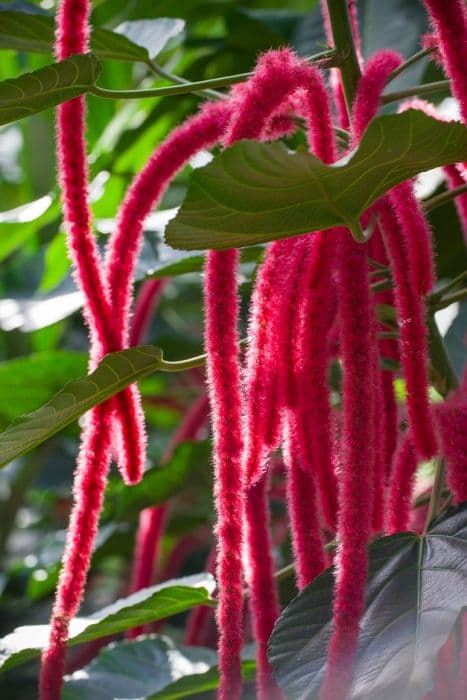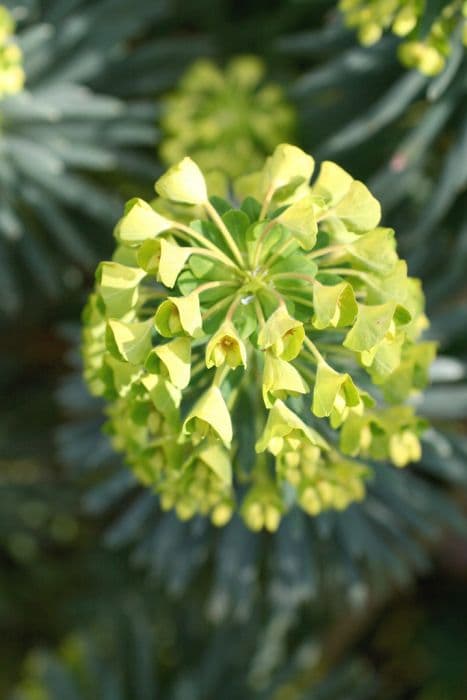Crown of Thorns Euphorbia milii

ABOUT
The Euphorbia milii, commonly known as the Crown of Thorns, is a succulent plant characterized by its woody, spiny stems. The sharp thorns, which can be quite prominent, cover these stems and are a notable defensive feature of the plant. Despite its formidable thorns, it is prized for its beautiful flowers, which are small and inconspicuous by themselves but are surrounded by showy and colorful bracts. These bracts are often mistaken for petals and come in a range of colors such as red, pink, yellow, and white, adding to the ornamental appeal of the plant. The leaves of the Crown of Thorns are fleshy and oblong, appearing most often at the end of the stems, lending a sparse yet lush look due to their glossy green color. This plant exhibits a tendency to drop its leaves during less favorable conditions, such as droughts, to conserve water and energy. During these times, the plant relies on its substantial water-storing capabilities, helped by the succulent nature of its stems and leaves. Overall, the Crown of Thorns is a striking plant with a contrasting appearance: the harsh, protective thorns on its stems and the vibrant, welcoming colors of its flowers. This duality makes it a popular choice for an ornamental houseplant or garden specimen that can thrive under a variety of conditions, as long as it receives enough light and warmth.
About this plant
 Names
NamesFamily
Euphorbiaceae
Synonyms
Crown of Thorns, Christ Plant, Christ Thorn
Common names
Euphorbia splendens, Euphorbia bojeri, Euphorbia milii var. splendens, Euphorbia milii var. hislopii
 Characteristics
CharacteristicsLife cycle
Perennials
Foliage type
Evergreen
Color of leaves
Green
Flower color
Varies
Height
1-4 feet (0.3-1.2 meters)
Spread
1-2 feet (0.3-0.6 meters)
Plant type
Shrub
Hardiness zones
9
Native area
Madagascar
Benefits
 General Benefits
General Benefits- Low-Maintenance: Euphorbia milii requires minimal care, making it ideal for busy or novice gardeners.
- Drought Tolerant: It is well adapted to arid environments, reducing the need for frequent watering.
- Long Blooming: The plant consistently produces flowers, providing vibrant color for extended periods.
- Pest Resistant: Euphorbia milii has a natural resistance to many pests, decreasing the need for chemical treatments.
- Thorny Protection: The thorns help protect the plant from herbivores and can be used as a natural barrier in gardens.
- Adaptable Growth: It can thrive in a range of environmental conditions, from indoor pots to outdoor landscapes.
- Decorative: With its striking flowers and thorny stems, it is often used for ornamental purposes in gardens and homes.
- Easy Propagation: The plant can easily be propagated from cuttings, allowing gardeners to multiply their plants without buying new ones.
 Medical Properties
Medical Properties- Anti-inflammatory: Euphorbia milii has been traditionally used to reduce inflammation.
- Analgesic: The plant has properties that may provide pain relief.
- Antimicrobial: Extracts of Euphorbia milii have been shown to possess antimicrobial properties against certain pathogens.
- Antifungal: It has potential applications in treating fungal infections due to its antifungal compounds.
- Emetic: In traditional medicine, the plant has been used to induce vomiting to remove ingested poisons.
 Air-purifying Qualities
Air-purifying QualitiesThis plant is not specifically known for air purifying qualities.
 Other Uses
Other Uses- Euphorbia milii can be used as a natural barrier or living fence because of its thorny stems, deterring unwanted animals and possibly intruders from entering garden spaces.
- The sap of Euphorbia milii is sometimes used as a fish poison in rural areas to capture fish due to its toxic properties.
- In some cultures, Euphorbia milii is used in religious and cultural ceremonies as a symbol of passion and Christ's crucifixion, referring to its common name, Crown of Thorns.
- Due to its drought-resistant nature, Euphorbia milii is often used in xeriscaping, a landscaping approach that reduces the need for irrigation.
- Euphorbia milii is used in landscape design to provide colorful accents with its bracts that function as pseudo-flowers, brightening gardens and parks.
- The various colorful varieties of Euphorbia milii are utilized in breeding programs to develop new ornamental plants with unique colorations and patterns.
- As a bonsai specimen, Euphorbia milii's ability to adapt to container life and its interesting form make it a unique choice for enthusiasts of the art form.
- The plant is used in education to teach about CAM (Crassulacean Acid Metabolism), a photosynthetic adaptation found in many succulents that allows them to conserve water.
- Euphorbia milii plays a role in the study of plant defense mechanisms, as its thorns and toxic sap are classic examples of plant adaptations against herbivory.
- In some tropical countries, the thick, fleshy leaves of Euphorbia milii are used as an impromptu writing surface or as a natural bookmark due to their durability and size.
Interesting Facts
 Feng Shui
Feng ShuiThe Crown of Thorns is not used in Feng Shui practice.
 Zodiac Sign Compitability
Zodiac Sign CompitabilityThe Crown of Thorns is not used in astrology practice.
 Plant Symbolism
Plant Symbolism- Persistence: Euphorbia milii, commonly known as Crown of Thorns, is a symbol of persistence due to its ability to thrive in harsh conditions and its hardy nature.
- Christ's Passion: The Crown of Thorns is closely associated with the passion of Christ, as its thorns are said to resemble the crown of thorns placed on Jesus' head.
- Protection: The sharp thorns of the Crown of Thorns plant are also symbolic of protection, suggesting the ability to guard oneself against harm or negative influences.
- Martyrdom: Because of its biblical connections, the plant can represent martyrdom, commemorating those who have suffered for their faith or beliefs.
- Eternal Love: Despite its thorny appearance, the Crown of Thorns blooms with small flowers, symbolizing enduring love that persists even through difficulties.
- Good Fortune: In some cultures, the Crown of Thorns is believed to bring good luck and is kept in homes to attract positive energy.
 Water
WaterThe Crown of Thorns plant requires moderate watering. Water the plant thoroughly until water runs out of the drainage holes, and then allow the soil to dry out before watering again. Generally, during the growing season, watering every 7 to 10 days will suffice. In winter months, reduce watering to once every 2 to 3 weeks. The plant is drought tolerant, so it is better to under-water than over-water; use roughly one to two cups or about 8 to 16 ounces of water per watering session for a standard pot size.
 Light
LightCrown of Thorns thrives in bright, indirect sunlight and can tolerate direct sunlight for part of the day. A south or west-facing window is a good spot for this plant. Be sure the plant is not exposed to prolonged periods of hot, direct sunlight, which may scorch the leaves.
 Temperature
TemperatureCrown of Thorns prefers temperatures between 60 and 75 degrees Fahrenheit but can survive in temperatures as low as 50 degrees Fahrenheit and as high as 90 degrees Fahrenheit. Keep the plant away from drafts and cold windows to prevent stress.
 Pruning
PruningPruning Crown of Thorns is generally done to shape the plant and remove any damaged or diseased stems. Prune the plant in late winter or early spring before new growth begins. This encourages a healthier, bushier growth pattern. Ensure that you use gloves and sterilize your pruning shears, as the sap is toxic.
 Cleaning
CleaningAs needed
 Soil
SoilThe best soil mix for Crown of Thorns should be well-draining, such as a cactus mix with added perlite or sand, with a soil pH around 6.0 to 7.5 to support healthy growth.
 Repotting
RepottingCrown of Thorns should be repotted every two to three years or when it has outgrown its current pot to ensure adequate space for root growth and nutrient uptake.
 Humidity & Misting
Humidity & MistingCrown of Thorns prefers average to dry humidity levels and can tolerate less humid environments common in most homes without special adjustments.
 Suitable locations
Suitable locationsIndoor
Keep Crown of Thorns in bright light and well-draining soil indoors for best growth.
Outdoor
Plant Crown of Thorns in full sun to partial shade and well-draining soil outdoors.
Hardiness zone
9-11 USDA
 Life cycle
Life cycleCrown of thorns (Euphorbia milii) begins its life as a seed, usually dispersed by animals or environmental factors. Upon finding suitable conditions with well-drained soil and ample sunlight, the seed germinates, developing roots, a shoot, and embryonic leaves in its initial growth stage. This is followed by the vegetative stage, where the plant grows vigorously, developing a thorny, woody stem and green leaves, using photosynthesis for energy. The plant reaches maturity when it starts flowering, producing small, inconspicuous flowers surrounded by colorful bracts that may mislead observers into thinking they are the petals. After pollination, typically by insects, the plant produces fruits, which are capsules containing seeds that are then dispersed to start new plants. Finally, in its perennial life cycle, the Crown of thorns may experience dormancy periods where growth slows, but it can live and flower for many years under proper conditions.
 Propogation
PropogationPropogation time
Spring to Summer
The Crown of Thorns, commonly known as Euphorbia milii, is best propagated through stem cuttings. This method is most popular due to its simplicity and high success rate. To propagate, choose a healthy stem and cut it to a length of about 4 to 6 inches (10 to 15 centimeters) using a clean, sharp knife or pruners. Allow the cutting to dry for a few days until the cut end forms a callous, which helps prevent rotting when planted. Then, insert the dried cutting into a well-draining soil mix, and keep it in bright, indirect sunlight. Water sparingly until the cutting establishes roots, which usually takes a few weeks. Once rooted, the plant can be treated as a mature Crown of Thorns, with regular watering and feeding.

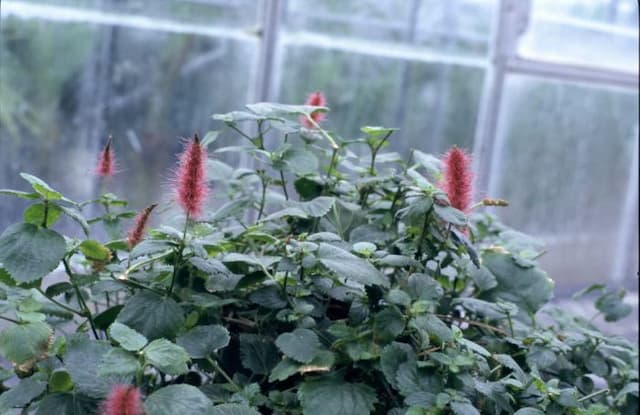
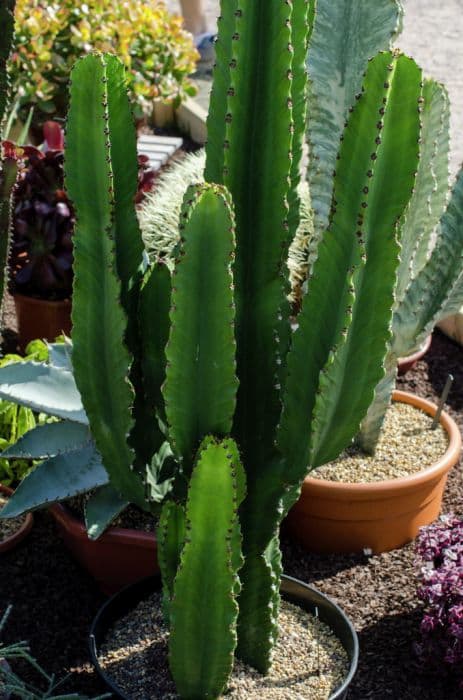
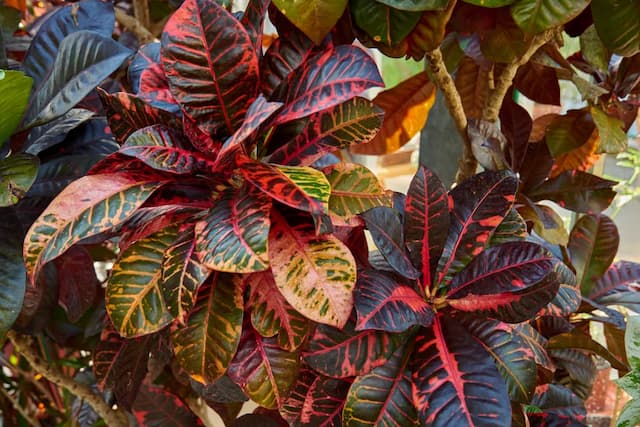
![Poinsettia [Jester Red]](/_next/image?url=https%3A%2F%2Fplants-admin.emdemapps.com%2Fimages%2Fplants%2F%2Fimages%2F604b55de5eb2c.png&w=640&q=75)


